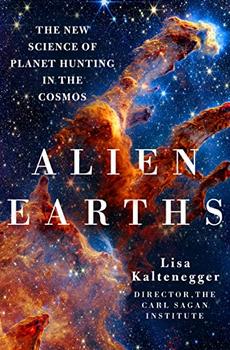Summary | Excerpt | Reviews | Beyond the Book | Read-Alikes | Genres & Themes | Author Bio

The New Science of Planet Hunting in the Cosmos
by Lisa KalteneggerThis article relates to Alien Earths
From the 17th century on, Johannes Kepler, Mary Shelley, Edgar Allan Poe, Jules Verne, HG Wells, and Edgar Rice Burroughs were just a few artists who contributed to a burgeoning awakening of the collective imagination, melding scientific and cosmic theories with myth and character, shaping something entirely new — science fiction.
How science fiction evolved from simple stories into a huge pop culture phenomenon could be an article unto itself. But it's worth noting that in 1966, science fiction was transformed forever when Star Trek premiered on NBC. In the show, the Starfleet organization was conceived with the goal of exploring and learning from our neighboring galaxies in the universe. Sound familiar? As it turns out, NASA was heavily inspired by Gene Roddenberry's groundbreaking series, and this influence ripples through the past and present like the ridges on a Klingon's forehead.
So why do real-life scientists love Star Trek so much? The show was launched at a time when the United States was in the toddler stage of space exploration. Smithsonian Air & Space Magazine contributor Glen E. Swanson, who's also a former historian of the NASA Johnson Space Center, offers key context: "When the Apollo 1 tragedy occurred, people had been flying into space for less than seven years. Spaceflight was new and dangerous, and here was a show that made it feel routine. Star Trek offered hope to a nation and a space program in a moment when both had reason to doubt they would ever reach the moon, never mind the 'new life and new civilizations' promised in the show's opening-credits monologue."
Even the official NASA website formally acknowledges Star Trek's influence on their programs: "In the 2016 documentary 'NASA on the Edge of Forever: Science in Space,' host NASA astronaut Victor J. Glover states, 'Science and Star Trek go hand-in-hand.' The film explores how for the past 50 years, Star Trek has influenced scientists, engineers, and even astronauts to reach beyond their potential."
In 1977, when NASA needed a fresh set of astronauts to work on upcoming projects, they asked Nichelle Nichols, who played Lt. Uhura, to assist. The Star Trek actress went on a four-month long campaign for NASA, and even filmed a recruitment video (see below) urging women and minorities to apply. The following year, NASA hired a new crop of 35 astronauts, "for the first time including women and minorities."
Trekkies (or Trekkers — choose your nomenclature) know that Star Trek is an enjoyable tool for understanding ourselves and each other. Our failings and misunderstandings, possible solutions to societal problems — all are speculated and commented upon in Star Trek. It shows us the future could be optimistic and peaceful, on Earth and beyond. According to Gene Roddenberry, "It's a program that said there is basic intelligence and goodness and decency in the human animal that will triumph."
For scientists, Star Trek and other works of science fiction offer elements of intrigue for the perpetually questioning and searching mind. According to Dr. Lisa Kaltenegger's new book, Alien Earths, "Astronomy and science fiction can be a quirky, unusual, and entertaining part of life ... Most astronomers I know enjoy science fiction, sometimes questioning how to implement its finer plot points."
When your job revolves around investigating the existence of life on other planets, it only makes sense. Delving into sci-fi led astronomers to wonder if we might find planets and star systems like those we read about and watch on TV. In Alien Earths, fun connections are made to works in the genre, including Star Trek.
"The triple-star system 40 Eridani is about sixteen lightyears away from Earth and consists of a slightly smaller orange star (40 Eridani A), a white dwarf (40 Eridani B), and a red sun (40 Eridani C). In the Star Trek franchise, the planet Vulcan, the home world of commander Spock, circles 40 Eridani A."
The significance of Star Trek and other sci-fi like it cannot be overstated. A child obsessed with the genre may one day grow up to be a scientist destined for the stars, fueled by the big ideas seen on screen. Daring to dream the impossible, working to make it a reality.
Filed under Medicine, Science and Tech
![]() This article relates to Alien Earths.
It first ran in the April 17, 2024
issue of BookBrowse Recommends.
This article relates to Alien Earths.
It first ran in the April 17, 2024
issue of BookBrowse Recommends.
Your guide toexceptional books
BookBrowse seeks out and recommends the best in contemporary fiction and nonfiction—books that not only engage and entertain but also deepen our understanding of ourselves and the world around us.